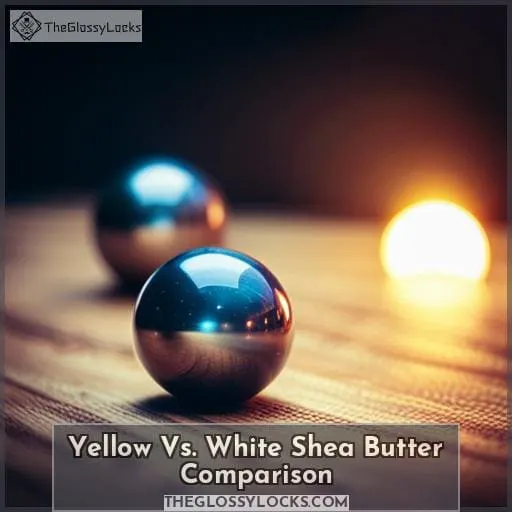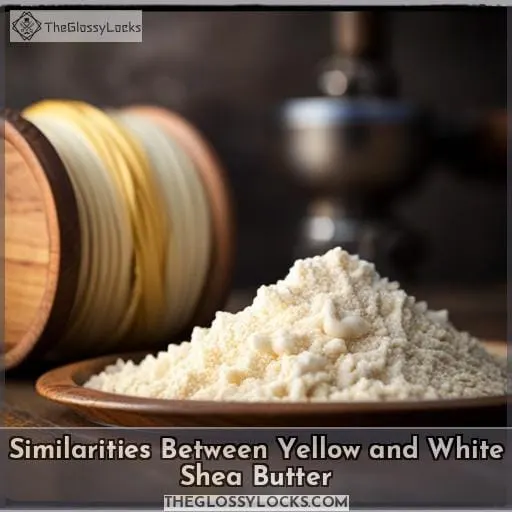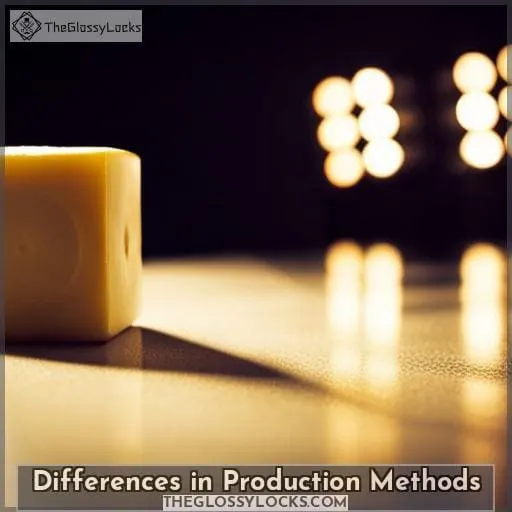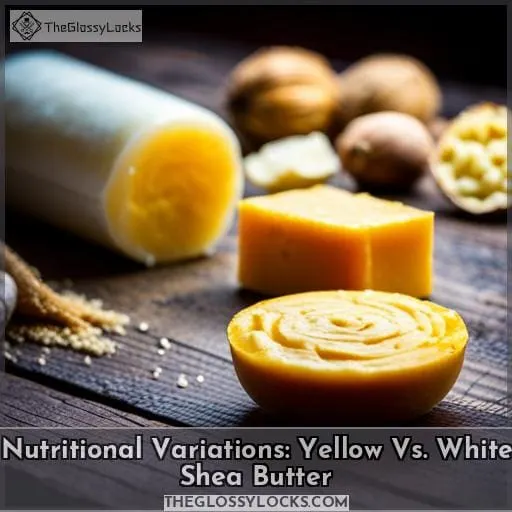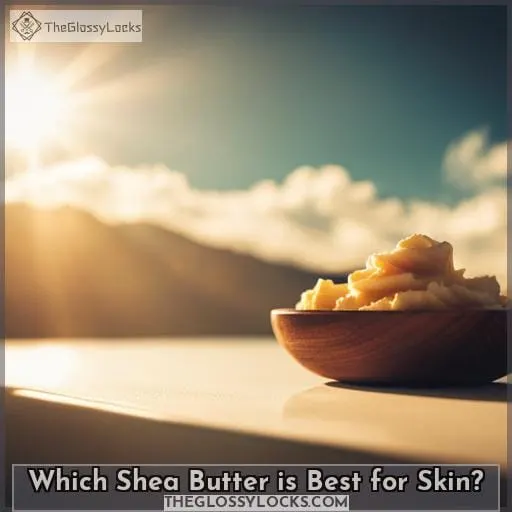This site is supported by our readers. We may earn a commission, at no cost to you, if you purchase through links.
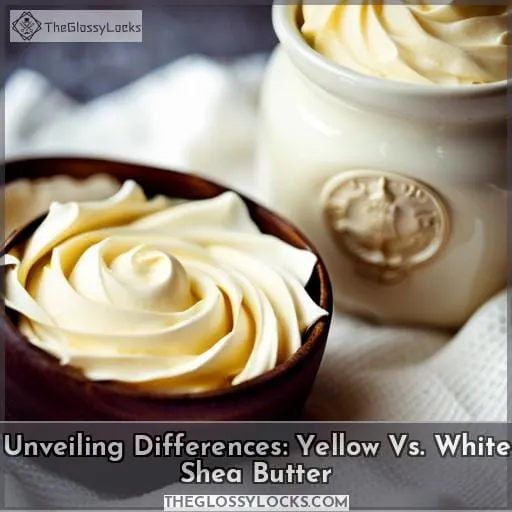 Explore the captivating realm of shea butter as we unveil the subtle distinctions between its yellow and white variants.
Explore the captivating realm of shea butter as we unveil the subtle distinctions between its yellow and white variants.
Embark on a journey through the contrasting realms of production methods and nutritional profiles, discovering the secrets behind their distinctive hues. Both yellow and white shea butter offer profound hydration and therapeutic properties.
Delve into the intricate complexities that set these two forms of skincare luxury apart. Understand the significance of production methods beyond mere coloration. Grasp the ideal shea butter for your skin’s unique needs and debunk myths surrounding yellow shea butter.
Elevate your skincare choices by delving into the nuanced universe of yellow and white shea butter. Empower your quest for deep, radiant hydration by comprehending the multifaceted world of shea butter varieties.
Table Of Contents
- Key Takeaways
- Yellow Vs. White Shea Butter Comparison
- Similarities Between Yellow and White Shea Butter
- Differences in Production Methods
- Nutritional Variations: Yellow Vs. White Shea Butter
- Which Shea Butter is Best for Skin?
- Debunking Myths About Yellow Shea Butter
- Considering Production Methods Over Color
- Choosing the Right Shea Butter for Deep Hydration
- Conclusion
Key Takeaways
- Distinct characteristics exist between yellow and white shea butter due to variations in processing methods and nutrient content.
- Yellow shea butter remains raw and nutrient-rich, preserving its natural benefits, thus rendering it ideal for skincare because of its elevated levels of vitamins A and E.
- Refined to a white color, shea butter experiences nutrient loss and a loss of aroma; therefore, it is best suited for external applications.
- The unprocessed nature of yellow shea butter ensures profound hydration, making it suitable for various skin types and granting it superior healing properties compared to white shea butter.
Yellow Vs. White Shea Butter Comparison
Dive into the world of skincare richness, where unrefined allure meets refined elegance, each variant bearing unique attributes in hue and essence. Shea color impact distinguishes yellow from white shea butter. Yellow, the raw, unrefined gem, boasts a warm, sunlit hue resonating with natural authenticity.
In contrast, the refined white exudes purity through its creamy, colorless canvas.
Skincare benefits diverge between the two. Yellow shea butter retains a treasure trove of natural nutrients, making it an ideal choice for addressing skin conditions and promoting healing. The unrefined variant’s nutrient retention bestows it with potent moisturizing abilities.
White shea butter, although refined for cosmetic use, loses some nutrients during processing.
Scent comparison highlights another contrast. Yellow shea butter carries an earthy, distinct aroma, a testament to its unadulterated nature. Meanwhile, white shea butter is often unscented, its refining process removing the potent scent.
Safety concerns also arise. Yellow shea butter, raw and pure, is safe even for consumption. On the other hand, white shea butter’s refining may involve chemicals, rendering it unfit for consumption.
Intriguing differences lie beneath the surface, shaping choices between yellow and white shea butter.
Similarities Between Yellow and White Shea Butter
Embark on a journey through the shared attributes of yellow and white shea butter. Explore the essence of their composition and the benefits they offer to your skin and hair. Whether yellow or white, shea butter exhibits remarkable similarities that go beyond their processing differences.
Their texture parallels provide a luxurious touch, making both variants suitable for various cosmetic applications.
Yellow shea butter retains its natural hue due to minimal processing, while white shea butter, despite refinement, maintains nutrient equivalence in certain aspects.
Both variants hold potent skincare benefits, each with unique qualities to cater to your needs. The rich color of yellow shea butter signifies its raw nature and impurities, whereas the refined appearance of white shea butter exudes purity.
However, their color differences arise from processing, geography, and season, rather than nutritional value.
From deep hydration to soothing relief, these forms of shea butter stand united in their commitment to nurture your skin and hair.
Experience liberation and intimacy with the shared essence of these variants, unlocking the potential for radiant and nourished skin through their harmonious attributes.
Differences in Production Methods
Explore the realm of production divergence as the methods behind these two variants unfold before you. The differences in refining techniques play a pivotal role in shaping the characteristics of yellow and white shea butter.
-
Raw vs. Refined: Raw, unrefined shea butter retains its natural integrity, harboring an abundance of nutrients and vitamins. In contrast, the refining process of white shea butter involves stripping away impurities, which unfortunately leads to some nutrient loss.
-
Processing Effects: The path to yellow shea butter involves minimal alteration—simply grounding, roasting, and boiling the nuts. Meanwhile, the journey to white shea butter is more intricate, encompassing refining stages that modify its color, odor, and nutrient content.
-
Nutrient Preservation: Yellow shea butter emerges as the victor in the nutrient preservation battle. Its raw state safeguards vitamins and beneficial compounds, making it an optimal choice for skin nourishment and healing.
Immerse yourself in the world of shea butter production methods, where the unrefined nature battles refined perfection, each with its unique benefits and characteristics.
Nutritional Variations: Yellow Vs. White Shea Butter
Moving from the differences in production methods, let’s delve into the Comparative Nutrients of yellow and white shea butter, bringing you closer to the intricacies of these skincare powerhouses. The variation in nutritional content between these two forms is not just a matter of color; it has profound implications for their Skin Benefits.
Below, a concise yet informative table breaks down the key elements, revealing the distinct attributes of each.
| Nutrient | Yellow Shea Butter | White Shea Butter |
|---|---|---|
| Vitamins A & E | Rich in vitamins for skin nourishment | Nutrient loss due to refining |
| Healing Properties | Enhanced healing potential | Diminished healing benefits |
| Nutrient Retention | Natural impurities can enhance efficacy | Refined process leads to loss |
| Chemical Concerns | None, when sourced from reputable places | Potential chemical traces from refining |
Yellow shea butter, with its intact vitamins and nutrients, offers robust Skincare Benefits, promoting healing and nourishment. On the other hand, white shea butter, due to refining, may lack in nutrient retention and could potentially contain trace chemicals.
Understanding these nuances empowers you to make informed choices about which shea butter suits your skincare needs best. From the richness of vitamins A and E to the potential of healing properties, the nutritional disparities play a pivotal role in your quest for radiant skin.
Which Shea Butter is Best for Skin?
For optimal skincare results, consider your preferences and needs when selecting the most suitable option between the two variants.
When it comes to skincare properties, yellow shea butter, with its unrefined nature, retains more nutrients and vitamins than its refined counterpart. This nutrient retention translates to enhanced skin healing benefits, making yellow shea butter particularly effective for addressing various skin conditions and rashes.
While both variants share similar cosmetic applications due to their comparable textures, individuals with specific texture preferences might find yellow shea butter more appealing due to its raw nature.
The refining process undergone by white shea butter impacts its composition, leading to nutrient loss and a lack of natural aroma.
Therefore, for those who prioritize nutrient retention and skin healing capabilities, yellow shea butter remains the superior choice, embodying the essence of well-nourished and revitalized skin for skincare enthusiasts seeking an intimate and liberating experience.
Debunking Myths About Yellow Shea Butter
Challenge misconceptions surrounding the natural hue, a hue that carries the essence of authenticity and unrefined goodness, by revealing the truth about its origin and attributes.
Yellow shea butter, often subject to myths about its color, is a powerhouse of unrefined goodness. Contrary to some beliefs, its vibrant hue isn’t a result of added dyes or marketing gimmicks. Instead, it’s a reflection of its natural state, untouched by the refining process.
Retaining vital nutrients like vitamins and healing properties, yellow shea butter stands as a top choice for skincare. Its color is a testament to nutrient retention, not an indication of impurities.
Furthermore, yellow shea butter is safe for external use and even consumption, in moderation. So, let go of the color misconceptions and embrace the unrefined facts. Its natural goodness and nutrient-rich composition make yellow shea butter an ideal choice for those seeking the full spectrum of shea butter benefits for their skin and hair.
Considering Production Methods Over Color
Consider the intricacies of production methods, going beyond surface hues, to truly grasp the essence of this skincare essential.
The refining process that sets yellow shea butter apart from its white counterpart significantly impacts its quality. Yellow shea butter retains its natural impurities and nutrients through minimal processing.
In contrast, the refining of white shea butter strips it of these beneficial elements. This refining process alters the composition, ultimately affecting both texture and nutrient retention.
Quality assessment becomes crucial. The raw, unrefined nature of yellow shea butter contributes to its superiority in skincare applications. Remember, these processing effects reach far beyond mere color. Nutrient preservation directly influences its effectiveness in benefiting your skin’s well-being.
In your search for high-quality shea butter, understanding these production intricacies empowers you to make informed choices. It’s important to consider not just the color but also the holistic benefits it offers for your skin.
Choosing the Right Shea Butter for Deep Hydration
Delve into the realm of optimal skincare hydration, unlocking nature’s deep replenishment for your skin’s vitality – a treasure bestowed by the richness of unrefined essence.
Experience the unparalleled Shea Texture Analysis that sets yellow shea butter apart. Its unprocessed nature ensures a thicker consistency, allowing for more intensive and longer-lasting hydration. The dense texture acts as a protective barrier, sealing in moisture and shielding your skin from harsh elements.
The hydration benefits of this variant extend beyond the surface, penetrating deep within the skin’s layers. The retained nutrients in yellow shea butter, like vitamins and fatty acids, nourish and rejuvenate, leaving your skin supple and youthful.
Skin compatibility is paramount, and yellow shea butter’s organic and unaltered composition makes it suitable for various skin types, even sensitive ones.
Application techniques are diverse – its rich texture requires warming between your palms before applying gently onto your skin.
Choose the right shea butter for deep hydration – opt for the unrefined, nutrient-packed yellow shea butter. Your skin deserves the best, and this variant ensures your quest for intensive, enduring moisture is met with nature’s finest.
Conclusion
Amidst the choice between yellow and white shea butter, a staggering statistic emerges: the unrefined, raw yellow variant retains its nutrients, making it a superior option for skincare. This finding underscores the significant differences between these two forms of shea butter.
While both exhibit similar textures and applications, their production methods and nutritional content differ significantly. When seeking optimal hydration and nourishment for your skin, it’s evident that yellow shea butter, enriched with natural goodness, reigns supreme.
Enhance your skincare regimen with the profound benefits of yellow shea butter and embrace the radiance it bestows.

